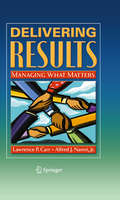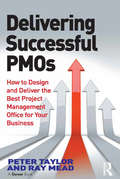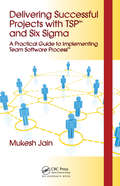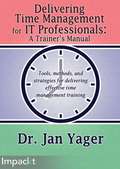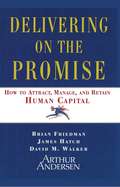- Table View
- List View
Delivering Results
by Lawrence P. Carr Alfred J. Nanni Jr.For any organization to perform and compete successfully, it must have the systems and processes in place to translate goals into achievable actions--and to measure and monitor results. Moreover, the organization must be able to adjust and adapt as market conditions, technologies, the competitive environment, government regulations, personnel, and other variables evolve, sometimes gradually and sometimes dramatically. In Delivering Results: Measuring What Matters, Babson College professors and management consultants, Lawrence Carr and Alfred Nanni, show managers how to avoid the common pitfalls and mistakes when setting corporate strategy, and instead create a management system--unique to their organization--that aligns internal resources with objectives, motivates and rewards employees, and continuously provides feedback. Illustrating their concepts with numerous real-life examples (both successes and failures), practical tools and models, and a glossary of key terms, the authors demonstrate that knowing how to create and direct management systems that deliver results is, in itself, a strategic resource.
Delivering Services in Multicultural Societies
by Alexandre MarcOver the last two decades the world has witnessed an important transformation of the concept of citizenship and social integration, increasingly recognizing that cultural and ethnic diversity need to be considered when designing and implementing social policies. The increasing cultural diversity of societies, along with the important role culture plays in forming identities in these societies, creates major challenges for national and local governments in ensuring social cohesion and social inclusion. 'Delivering Services in Multicultural Societies' reviews recent approaches to recognizing cultural diversity when delivering basic services. It first discusses how supporting cultural diversity can help achieve social inclusion and social cohesion. It then considers the debate over multiculturalism from various perspectives and discusses the risks and benefits of policies that support cultural diversity. Also examined are policies and programs that support cultural diversity in the delivery of basic services, such as education, health care, customary law, traditional governance systems, and cultural services. For each of these services the author reviews main challenges and describes best practices. Finally, the book offers a synthesis of what has been learned about taking cultural diversity into account in service delivery.
Delivering Strategic Human Resource Management
by Boris Groysberg Andrew N. Mclean Cate ReavisThis note reviews the history of the human resources (HR) function and the strategic human resources management (SHRM) movement, wherein HR managers' aspired to be strategic partners with line managers. Reviews practices for implementing a strategic-business-partner model for HR with a focus on the strategy, structures, and systems companies need to implement, and the skills that aspiring SHRM leaders need to develop in order to successfully play a strategic role. Also explores line managers' perceptions of new HR roles, and what capabilities they most want HR leaders to have in those roles.
Delivering Successful PMOs: How to Design and Deliver the Best Project Management Office for your Business
by Peter Taylor Ray MeadDelivering Successful PMOs is intended to be the companion book to Leading Successful PMOs (Peter Taylor) which was a guide to all project based organisations providing a common language to describe the variety of possible PMOs, explaining how to do the right things, in the right way, in the right order, with the right team, and identifying what made a good PMO leader. Delivering Successful PMOs takes this to the next level and provides a clear framework to conceive, design, build, prove and embody an enterprise PMO inside an organisation, dealing with the strategic intentions, the politics, the people and the projects. The book draws on the rare experience that Ray Mead, through his organisation p3m global(www.p3m.global) had in building an enterprise PMO for a major organisation (based in the Middle East) from the ground up - a ’greenfield’ enterprise PMO. Through this process he and his team have developed an invaluable methodology that is shared through this book alongside a real case study - this is not theory, this is not ’perfect’ world modelling, this is proven through practice and live application. Peter and Ray extend the guidelines from the first book and weave them in to the process of delivering a PMO that works for an organisation and delivers success - measured by improved project health, greater returns on investment, a better project management community, closer connection to business strategy and a more mature project organisation.
Delivering Successful Projects with TSP(SM) and Six Sigma: A Practical Guide to Implementing Team Software Process(SM)
by Mukesh JainDelivering successful projects means the ability to produce high quality software within budget and on time-consistently, but when one mentions quality to software engineers or project managers, they talk about how impossible it is to eliminate defects from software. This assumption is passed on and on until it becomes accepted wisdom, with the power of a self-fulfilling prophecy. And when a project fails to arrive on time or up to standards, team members will turn on each other. The project got delayed because the engineers did a poor job in development or too much was promised upfront for this short of a timeline.In Delivering Successful Projects with TSPSM and Six Sigma: A Practical Guide to Implementing Team Software ProcessSM, you will learn how to effectively manage the development of a software project and deliver it in line with customer expectations. This refreshing volume -Offers real-world case studies about the author's experience at Microsoft successfully implementing TSP to achieve higher quality softwareEmpowers software developers to take responsibility for project managementExplains how Six Sigma and TSP combined can dramatically reduce software defectsBy applying these principles put forth by one of the most respected names in software development, your software team will learn how to function as a team and turn out products where zero defects and on-time delivery are the norm.
Delivering Sustainable Growth in Africa
by Takahiro FukunishiThe purpose of this book is to fill the lack of micro evidences on a structural change of African producers. By collecting studies on single industries, we attempt to demonstrate firms' and farmers' responses to the recent economic trend such as growth of demand, emergence of FDI and improvement in infrastructure.
Delivering Time Management for IT Professionals: A Trainer's Manual
by Dr Jan YagerIf you want to create an efficient and high performing team, use this book to help your employees develop strong time management skills that will bring personal and team success.
Delivering on the Promise: How to Attract, Manage and Retain Human Capital
by Brian FriedmanBusiness has long struggled with the notion of "human capital," but do companies really know the value of their people? All too frequently, companies lay off thousands of workers to boost share price while, at the same time, their annual reports promise that "people are our greatest asset!" Now, for the first time, human capital experts Brian Friedman, James Hatch, and David M. Walker show how companies can deliver on this promise. They reveal how Arthur Andersen's breakthrough five-stage framework, "Human Capital Appraisal," enables managers to measure, manage, and leverage their companies' investment in people. The authors describe specifically how managers can evaluate the current effectiveness of a firm's human capital strategies and the efficiency of its current Human Resources programs. They explain how to measure the amount of time and money management spends to recruit, develop, and manage human resources. Then they focus on how a firm can assess the return on this investment, minimize risk, and leverage the value of its human capital resources. Finally, the authors demonstrate how such leading companies as Colgate Palmolive, The Chicago Tribune, Mobil Oil, The Body Shop, Holy Cross Hospital, Hyatt Hotels, IBM, and British Petroleum are realizing the value of their people through human capital programs. This unique, proven, and proprietary methodology makes this invaluable book required reading for every chief executive, human resources director, and line manager.
Delivering the Goods at Shippo
by Jeffrey J. Bussgang Jeffrey F. Rayport Olivia HullLaura Behrens Wu, CEO of software start-up Shippo, prepares her pitch for a Series A funding round following a successful seed round. Customer adoption of Shippo's e-commerce dashboard application, which allows small and medium retailers to compare delivery rates between shipping providers and print package labels, has been steady in the nine months since it went live. But traction with the firm's developer-friendly product, an API that allows large enterprise customers to automate their shipping needs, had initially been slow until one customer single-handedly tripled the API label volume in late August. Now in November 2014, with nine months of runway remaining, Behrens Wu must decide where to direct the company's limited resources. Should Shippo stay focused on the app while raising the next round of funding, pivot to an API-focused strategy, or pursue both products?
Delivering the Goods at Shippo
by Jeffrey J. Bussgang Olivia Hull Jeffrey RayportLaura Behrens Wu, CEO of software start-up Shippo, prepares her pitch for a Series A funding round following a successful seed round. Customer adoption of Shippo's e-commerce dashboard application, which allows small and medium retailers to compare delivery rates between shipping providers and print package labels, has been steady in the nine months since it went live. But traction with the firm's developer-friendly product, an API that allows large enterprise customers to automate their shipping needs, had initially been slow until one customer single-handedly tripled the API label volume in late August. Now in November 2014, with nine months of runway remaining, Behrens Wu must decide where to direct the company's limited resources. Should Shippo stay focused on the app while raising the next round of funding, pivot to an API-focused strategy, or pursue both products?
Delivering the Guest Experience: Successful Hotel, Lodging and Resort Management
by Michael CollinsExceptional customer experiences and financial returns are interdependent, whether a lodging operation is a luxury resort and spa, or a select-service economy hotel. Successful Hotel, Lodging & Resort Management: Delivering the Guest Experience fully explores this synergistic relationship. Successful Hotel, Lodging & Resort Management: Delivering the Guest Experience is based upon over four decades of hands-on industry experiences enjoyed by the authors. This title focuses on the application of sound customer service theory and best industry practices within the context of a hotel, lodging, and resort setting.
Delivery Problems at Arrow Electronics, Inc. (A)
by Kerry Herman Frances X. Frei Andrew McAfeeDescribes a dramatic decrease in service levels (on-time shipments) from the warehouse network of a large electronics distributor. Students need to analyze the root cause of the problem and propose actions. A rewritten version of an earlier case.
Delivery Problems at Arrow Electronics, Inc. (A)
by Andrew Mcafee Kerry Herman Frances X. FreiDescribes a dramatic decrease in service levels (on-time shipments) from the warehouse network of a large electronics distributor. Students need to analyze the root cause of the problem and propose actions. A rewritten version of an earlier case.
Delivery of Goods under Bills of Lading
by Anders MøllmannProbably the core characteristic of a bill of lading is that the original bill of lading must be presented at the port of destination for a consignee to be entitled to delivery of the goods and for the carrier to get a good discharge of its delivery obligation by delivering the goods to said consignee. This notion is accepted virtually worldwide, but the more precise content of the "presentation rule" differs from jurisdiction to jurisdiction. Furthermore, and of importance, the legal basis establishing the "presentation rule" differs. With the technological advances in maritime transport as well as in communications technology and the emergence of more complicated trading patterns, a system where a specific tangible piece of paper issued at the port of loading has to be presented at the port of discharge to obtain delivery of the goods seems almost archaic and can obviously create problems. Thus, in practice very often – especially in some trades such as the oil trade – the bill of lading is not available at the port of discharge when the ship is ready to deliver the cargo. The book will first analyse the "presentation rule", its finer contents and its legal basis. It will then go on with (legal) analyses of three developments and responses to the problems that the bill of lading system gives rise to in practice, viz. the commercial, the international legislature’s, and the technological response. The commercial response analysed here consists of contractual exemption or limitation clauses in the bill of lading set up as a defence against claims for misdelivery. The international legislature’s response denotes the adoption of the Rotterdam Rules which as the first international convention on carriage of goods by sea includes elaborate rules on delivery of the goods. Finally, the technological response denotes the possibility of using electronic (equivalents of) bills of lading. The analyses will include a comparative approach examining both English and Scandinavian law to elucidate the issues with greater clarity.
Dell Computer Corp.
by V. Kasturi Rangan Das NarayandasTraces the evolution of the personal computer industry over the last 20 years and uses this as a backdrop to look at how Dell Computer Corp. grew from a small start-up to a multi-billion-dollar company in a decade. Dell is now faced with a set of decisions on the product markets it needs to serve in order to sustain its growth profitably into the future.
Dell Computer Corp.
by Peter Tufano Jonathan S. HeadleyTina Chen, chief investment officer of a large insurance company, hears accusations by a Kidder Peabody equity research analyst that Dell Computer Corp. might be improperly accounting for what he suspects are large foreign exchange losses resulting from speculation. She must recommend what position to take in Dell's stock and attempts to understand the various financial instruments and strategies Dell could have used in its foreign exchange operations. She must also understand how Dell accounted for its foreign exchange transactions and make some sense of the conflicting views of outside experts on the controversy.
Dell Computers (A): Field Service for Corporate Clients
by Amy C. Edmondson Frances X. Frei Corey HajimExplores the highly successful PC and low-end server manufacturer's entry into the large-scale server market in the United States. A key difference of this new market is the intense service element required to support the larger hardware. Specifically, the industry standard is to have a technician onsite with a required part within four hours of problem diagnosis. This type of service presents a problem for Dell, as its potential customers are widely dispersed throughout the United States. Should Dell create an in-house field service team to ensure service quality and maintain control of its customer relationships or outsource the field service to a third-party provider? Complicating the issue is the presence of IBM, the biggest player in the large-scale server market.
Dell Online
by V. Kasturi Rangan Marie BellDell started online commerce for its PCs in 1996, and by 1997 had achieved a sales rate of $3 million a day. The case describes the internal process that led to these dramatic results and poses the question of how the firm should leverage this activity to meet Michael Dell's goal of achieving 50% of the company's anticipated $20 billion in sales by the year 2000 via Internet channels.
Dell Technologies: Bringing the Cloud to the Ground
by V. Kasturi Rangan Navid MojirThe case tells the story of Dell Technologies and its efforts to revitalize its value proposition and escape a commodity trap by acquiring EMC for $67 billion -- the largest tech acquisition in history. It also shows the deeply intertwined connections between a company's business strategy and its go-to-market operations.Michael Dell founded Dell Inc. in 1984 to assemble PCs. The company quickly became the market share leader by the end of the century. By 2008 (before the recession), Dell had expanded into servers, networking and storage, as well as services. Still, the hardware market was beginning to commoditize, with the trend accelerating after the recession. EMC, founded in 1979, had a similar story. It became the dominant player in data storage through early 2000 only to find that new technologies and nimble competitors were putting its business under severe commodity pressure by the turn of the century. Thus in 2015, when Dell made a $67 billion acquisition of EMC, many knowledgeable IT industry observers found it hard to comprehend the logic of two commodity/hardware players coming together. By then, most enterprises, large and small, were eyeing digital transformation. Cloud service providers such as Amazon Web Services, Microsoft Azure, and Google Cloud seemed to be serving their needs. Thus, Michael Dell had to carefully construct a strategic position for the newly constituted Dell company in the rapidly evolving IT market space. In addition, Dell and EMC also had to decide how to merge their Go-to-Market operations to gain the synergies promised by the merger. Dell had over 365,000 customers and EMC nearly 430,000. Dell had 17,000 salespeople and EMC, 7,000. Each had over 10,000 channel partners. Adding a wrinkle to the merger was a third actor, VMware, an independently listed cloud software company, 80% owned by the new Dell Technologies entity. Integrating their software capability would be an exciting opportunity and a challenge.
Dell's Working Capital
by Aldo Sesia Richard S. RubackDell Computer Corp. manufactures, sells, and services personal computers. The company markets its computers directly to its customers and builds computers after receiving a customer order. This build-to-order model enables Dell to have much smaller investment in working capital than its competitors. It also enables Dell to more fully enjoy the benefits of reduction in component prices and to introduce new products more quickly. Dell has grown quickly and has been able to finance that growth internally by its efficient use of working capital and its profitability. This case highlights the importance of working capital management in a rapidly growing firm.
Dell--New Horizons
by V. Kasturi Rangan Marie BellFounded in 1984, Dell Corp. has achieved phenomenal growth, and by 2000 had topped $25 billion in sales and over $2 billion in net income. In the 4th quarter of 2000, however, the PC industry's average 30-year growth rate crashed to a negative 10%. Dell must make difficult decisions on how to sustain its profitability in light of its broad product portfolio--PCs, workstations, and servers on storage products for a broad cross section of customers in the United States and worldwide. Should it stay the course or fundamentally change strategy?
Deloitte & Touche (A): A Hole in the Pipeline
by Rosabeth Moss Kanter Jane RoessnerDeloitte & Touche was losing talented women, and CEO Mike Cook wanted to stop the loss, especially as the accounting and consulting fields became more competitive. The firm commissioned an analysis of the situation; now it had to consider the results and develop a plan change.
Deloitte & Touche (B): Changing the Workplace
by Rosabeth Moss Kanter Jane RoessnerDeloitte & Touche women's initiative changed the workplace culture at the firm, solved retention problems, and brought external benefits. Now a new CEO must decide how to take this a step further as competition for talent was even stronger, young people had different needs and aspirations, and the firm's global offices had not yet embraced this U.S. initiative.
Deloitte & Touche Consulting Group
by David M. Upton Christine SteinmanExamines two dilemmas often faced by an operations consultant. First, the dual responsibility to both client and consulting firm. Second, the management of the often competing pressure to deliver immediate results, at the same time laying the foundation for long-term performance improvement.
Deloitte's Pixel (A): Consulting with Open Talent
by Michael L. Tushman John Winsor Kerry HermanDeloitte Consulting's General Manager Balaji Bondili, head of Pixel, considers how best to grow Deloitte Consulting's use of open (on-demand) talent, as consulting companies and their clients face transformative change in the way client engagements and projects get done. Pixel, started in 2014, helps facilitate open (or on-demand) talent and crowdsourcing for Deloitte Consulting client engagements, to access specific, difficult-to-find expertise, collaborate to develop new products and/or insights, and to design, build, and test new digital assets. Bondili has found some avid users-and evangelists-of Pixel's services among Deloitte Consulting's principals, however uptake across the broader organization has been slow, and in some pockets has met with deep resistance.
